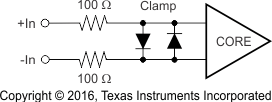ZHCSP72A August 2020 – November 2021 OPA2388-Q1 , OPA388-Q1
PRODUCTION DATA
7.3.2 Input Differential Voltage
The typical input bias current of the OPAx388-Q1 during normal operation is approximately 30 pA. In overdriven conditions, the bias current can increase significantly. The most common cause of an overdriven condition occurs when an operational amplifier is outside of the linear range of operation. When the output of the operational amplifier is driven to one of the supply rails, the feedback loop requirements cannot be satisfied and a differential input voltage develops across the input pins. This differential input voltage results in activation of parasitic diodes inside the front-end input chopping switches that combine with 10-kΩ electromagnetic interference (EMI) filter resistors to create the equivalent circuit shown in Figure 7-4. Notice that the input bias current remains within specification in the linear region.
 Figure 7-4 Equivalent Input
Circuit
Figure 7-4 Equivalent Input
Circuit